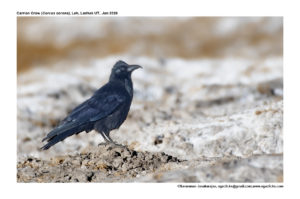
Carrion Crow Corvus corone
Etymology:
Nominate:
- Corvus : Latin word for Raven
- Corone : Greek word –korone -crow
Sub-species:
- c. orientalis– Latin word for East
Vernacular Name : Hindi: Kala kawwa, Pahari kawwa, Jungli kawwa, Sans: Van kak, Kash: Kav, Diva kav, Pantsol kav, Pahari: Kak, Pun: Paharikan, Rakan, Bi: Kagh, Ben: Dand kak, Jangli kowwa, Dhora kaori, Ass: Dhora kaori, Mani: Kwak, Lepcha: Ulakpho, Cachar: Hagrani dao-kak, Naga: Inrui kak, Kuki: Vo kak, Bhutan: Ulak, Ola, Guj: Girari/Girnari kagdo, Mar: Dom kavla, Ori: Damarakau, Ta: Andan kakai, Karun kakai, Te: Mala kaki, Nalla kaki, Mal: Tonnan kakka, Beli kakka, Kan: Kadu kaage, Karvi kaage, Sinh: Kaka, Kaputa
Distribution in India: C. c. orientalis – Resident of Kashmir and Ladhak
Description: Size of 48–53 cm; wt. of 396–602 g. It is a rather compact archetypal crow with relatively flat crown running onto slightly arched culmen. The plumage is wholly black, greenish hue on head and wings becoming more purplish-red on rest of upperparts, the lower underparts are dull black. In worn plumage, it becomes very dull, unglossed black overall. The iris is dark brown; bill and legs are black. Both the sexes are similar. The juvenile has plumage duller and rather looser, sootier black, than adult, also greyer iris and pinkish-red interior of mandibles which is grey in adults, and may show pale or fleshy gape-flanges into first autumn. The birds with whitish patches on wings are not unusual, and seem invariably to be first-years. Races differ only in size: orientalis is on average larger than nominate, and has larger, stouter bill, largest in east of range.
Habitat: It is found in open country, amongst scattered trees, farmland, parks and gardens, forest clearings, moorland and on inshore islands, coastal cliffs and estuarine flats. The Nominate race ascends to 2000 m; and race orientalis reaches 3600 m.
Food Habits: It is omnivorous, but mainly a carnivorous scavenger. It diet varies according to local habitats, but consists basically of invertebrates, especially earthworms, small mammals, frogs, bird eggs and nestlings, as well as carrion; in addition, small amounts of grain and weed seeds eaten. It feeds almost entirely on ground, turning over seaweed, dung or stones to get at insects and other invertebrates. It, will pursue other birds to make them drop or regurgitate food items.
Breeding habits: They breed Mar-May. They are single-brooded. They are Monogamous and have long-term pair-bond, pair-members keeping together throughout year. The nest is built by both sexes, female doing bulk of the work, work normally taking 20 days. The nest is a rather large structure based on sticks and twigs, often mixed with rabbit bones or wire and heather twigs. Mud is pushed into base to give a solid foundation. The deep cup is thickly lined with soft materials such as wool, animal fur, soft grasses, feathers and paper; built mainly in crown of tall tree. They normally build a fresh nest built each year. They lay a clutch of 4 eggs. The incubation is done almost entirely by female, fed on or near nest by male. Incubation period is 17–22 days. The chicks are fed by both parents. The chicks leave nest after 30–34 days; young dependent on adults for several further weeks. Their old nests used by a number of other birds, including Long-eared Owls, Sparrowhawk and various falcons.